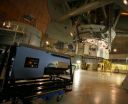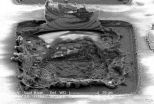(Press-News.org) It seems counterintuitive that clouds over the Southern Ocean, which circles Antarctica, would cause rain in Zambia or the tropical island of Java. But new research finds that one of the most persistent biases in global climate models – a phantom band of rainfall just south of the equator that does not occur in reality – is caused by poor simulation of the cloud cover thousands of miles farther to the south.
University of Washington atmospheric scientists hope their results help explain why global climate models mistakenly duplicate the inter-tropical convergence zone, a band of heavy rainfall in the northern tropics, on the other side of the equator. The study appears this week in the Proceedings of the National Academy of Sciences.
"There have been tons of efforts to get the tropical precipitation right, but they have looked in the tropics only," said lead author Yen-Ting Hwang, a UW doctoral student in atmospheric sciences. She found the culprit in one of the most remote areas of the planet.
"What we found, and that was surprising to us, is the models tend to be not cloudy enough in the Southern Ocean so too much sunlight reaches the ocean surface and it gets too hot there," Hwang said. "People think of clouds locally, but we found that these changes spread into the lower latitudes."
Previous studies investigated tropical sea-surface temperatures, or ways to better represent tropical winds and clouds. But none managed to correctly simulate rainfall in the tropics – an important region for global climate predictions, since small shifts in rainfall patterns can have huge effects on climate and agriculture.
"The rain bands are very sharp in this area," commented co-author Dargan Frierson, a UW associate professor of atmospheric sciences. "You go from some of the rainiest places on Earth to some of the driest in just a few hundred kilometers."
Recent theories suggest tropical rainfall might be linked to global processes. Hwang's research, funded by the National Science Foundation, looked for possible connections to ocean temperatures, air temperatures, winds and cloud cover.
"For the longest time we were expecting that it would be a combination of different factors," Frierson said, "but this one just stood out."
The paper shows that cloud biases over the Southern Ocean are the primary contributor to the double-rain band problem that exists in most modern climate models.
"It almost correlates perfectly," Hwang said. "The models that are doing better in tropical rainfall are the ones that have more cloud cover in the Southern Ocean."
Hwang will speak on her results in April to scientists at the World Climate Research Programme. The results have also been submitted for inclusion in the fifth report of the Intergovernmental Panel on Climate Change, which is expected to appear next year.
Most models don't generate enough low-level clouds over the perpetually stormy Southern Ocean, the authors found, so heat accumulates in the Southern Hemisphere.
"Basically hot air rises, and it rains where air rises. So it's kind of obvious that the rain is going to be over warmer ocean temperatures," Frierson said. "Our new thinking is that the heat spreads – it's the warmth of the entire hemisphere that affects tropical rainfall."
In the short term, climate scientists can look for ways to improve the models to increase cloud cover over the Southern Ocean. Eventually, more powerful computers may permit models that are able to accurately simulate clouds over the entire planet.
"We have confidence in climate predictions outside the tropics, but tropical rainfall forecasts are much less certain," Frierson said. "We hope this work will lead to better rainfall forecasts in regions like equatorial Africa, where it's so important to have accurate predictions of future patterns."
###
For more information, contact Hwang at 206-543-0333 or yting@atmos.washington.edu and Frierson at 206-685-7364 or dargan@atmos.washington.edu. Ting is traveling until March 17 and is best reached via e-mail.
Remote clouds responsible for climate models' glitch in tropical rainfall
2013-03-12
ELSE PRESS RELEASES FROM THIS DATE:
Long-suspected cause of blindness from eye disease disproved
2013-03-12
(SALT LAKE CITY)—Vision scientists long have thought that lack of very long chain fatty acids in photoreceptor cells caused blindness in children with Stargardt type 3 retinal degeneration, an incurable eye disease. But researchers at the University of Utah's John A. Moran Eye Center have shown in a new study that lack of these fatty acids does not cause blindness, meaning that the search for the mechanism that robs sight from children with the disease must start anew.
Researchers led by David Krizaj, Ph.D., associate professor of ophthalmology and visual sciences at ...
Common erectile dysfunction drug not helpful for heart failure patients, study finds
2013-03-12
SAN FRANCISCO -- A commonly used erectile dysfunction drug, sildenafil, doesn't help patients who have heart failure with preserved ejection fraction, a condition in which the heart's lower chambers are stiff and cannot relax and fill fully between beats. That is the finding of the RELAX study, presented today at the American College of Cardiology's 62nd Annual Scientific Session and simultaneously published in The Journal of the American Medical Association. The study's lead author called the results disappointing.
Sildenafil, a phosphodiesterase-5 inhibitor, had shown ...
Astronomers conduct first remote reconnaissance of another solar system
2013-03-12
Researchers have conducted a remote reconnaissance of a distant solar system with a new telescope imaging system that sifts through the blinding light of stars. Using a suite of high-tech instrumentation and software called Project 1640, the scientists collected the first chemical fingerprints, or spectra, of this system's four red exoplanets, which orbit a star 128 light years away from Earth. A detailed description of the planets—showing how drastically different they are from the known worlds in the universe—was accepted Friday for publication in The Astrophysical Journal. ...
Creating indestructible self-healing circuits
2013-03-12
PASADENA, Calif.—Imagine that the chips in your smart phone or computer could repair and defend themselves on the fly, recovering in microseconds from problems ranging from less-than-ideal battery power to total transistor failure. It might sound like the stuff of science fiction, but a team of engineers at the California Institute of Technology (Caltech), for the first time ever, has developed just such self-healing integrated chips.
The team, made up of members of the High-Speed Integrated Circuits laboratory in Caltech's Division of Engineering and Applied Science, ...
Epigenetics mechanism may help explain effects of mom's nutrition on her children's health
2013-03-12
This press release is available in Spanish.
Pioneering studies by U. S. Department of Agriculture-funded research molecular geneticist Robert A. Waterland are helping explain how the foods that soon-to-be-moms eat in the days and weeks around the time of conception—or what's known as periconceptional nutrition–may affect the way genes function in her children, and her children's health.
In an early study, Waterland and co-investigators examined gene function of 50 healthy children living in rural villages in the West African nation of The Gambia. The study has shaped ...
Study shows how one insect got its wings
2013-03-12
COLUMBUS, Ohio – Scientists have delved deeper into the evolutionary history of the fruit fly than ever before to reveal the genetic activity that led to the development of wings – a key to the insect's ability to survive.
The wings themselves are common research models for this and other species' appendages. But until now, scientists did not know how the fruit fly, Drosophila melanogaster, first sprouted tiny buds that became flat wings.
A cluster of only 20 or so cells present in the fruit fly's first day of larval life was analyzed to connect a gene known to be active ...
Study predicts lag in summer rains over parts of US and Mexico
2013-03-12
A delay in the summer monsoon rains that fall over the southwestern United States and northwestern Mexico is expected in the coming decades according to a new study in the Journal of Geophysical Research. The North American monsoon delivers as much as 70 percent of the region's annual rainfall, watering crops and rangelands for an estimated 20 million people.
"We hope this information can be used with other studies to build realistic expectations for water resource availability in the future," said study lead author, Benjamin Cook, a climate scientist with joint appointments ...
Study shows on-pump bypass comparable to off-pump at year mark
2013-03-12
SAN FRANCISCO (March 11, 2013) — Patients who underwent heart bypass surgery without a heart- lung machine did as well one year later as patients whose hearts were connected to a pump during surgery in a study presented today at the American College of Cardiology's 62nd Annual Scientific Session.
CORONARY, an international, multicenter trial of on-pump (with a heart-lung machine) versus off-pump bypass surgery, enrolled 4,752 patients already scheduled to undergo a bypass procedure. The study is the largest to compare the two approaches.
For the primary endpoint of ...
University of Maryland School of Medicine discovers adaptations to explain strategies for survival on Mars
2013-03-12
Research from the University of Maryland School of Medicine has revealed key features in proteins needed for life to function on Mars and other extreme environments. The researchers, funded by NASA, studied organisms that survive in the extreme environment of Antarctica. They found subtle but significant differences between the core proteins in ordinary organisms and Haloarchaea, organisms that can tolerate severe conditions such as high salinity, desiccation, and extreme temperatures. The research gives scientists a window into how life could possibly adapt to exist on ...
Similar outcomes in older patients with on- or off-pump bypass
2013-03-12
SAN FRANCISCO (March 11, 2013) — Older patients did as well after undergoing coronary bypass surgery off-pump as they did with the more costly "on-pump" procedure using a heart-lung machine to circulate blood and oxygen through the body during surgery, according to research presented today at the American College of Cardiology's 62nd Annual Scientific Session.
This large, multicenter trial—the German Off-Pump Coronary Artery Bypass Grafting in Elderly Patients, called GOPCABE—was the first to evaluate on-pump versus off-pump bypass surgery among patients aged 75 or older. ...


